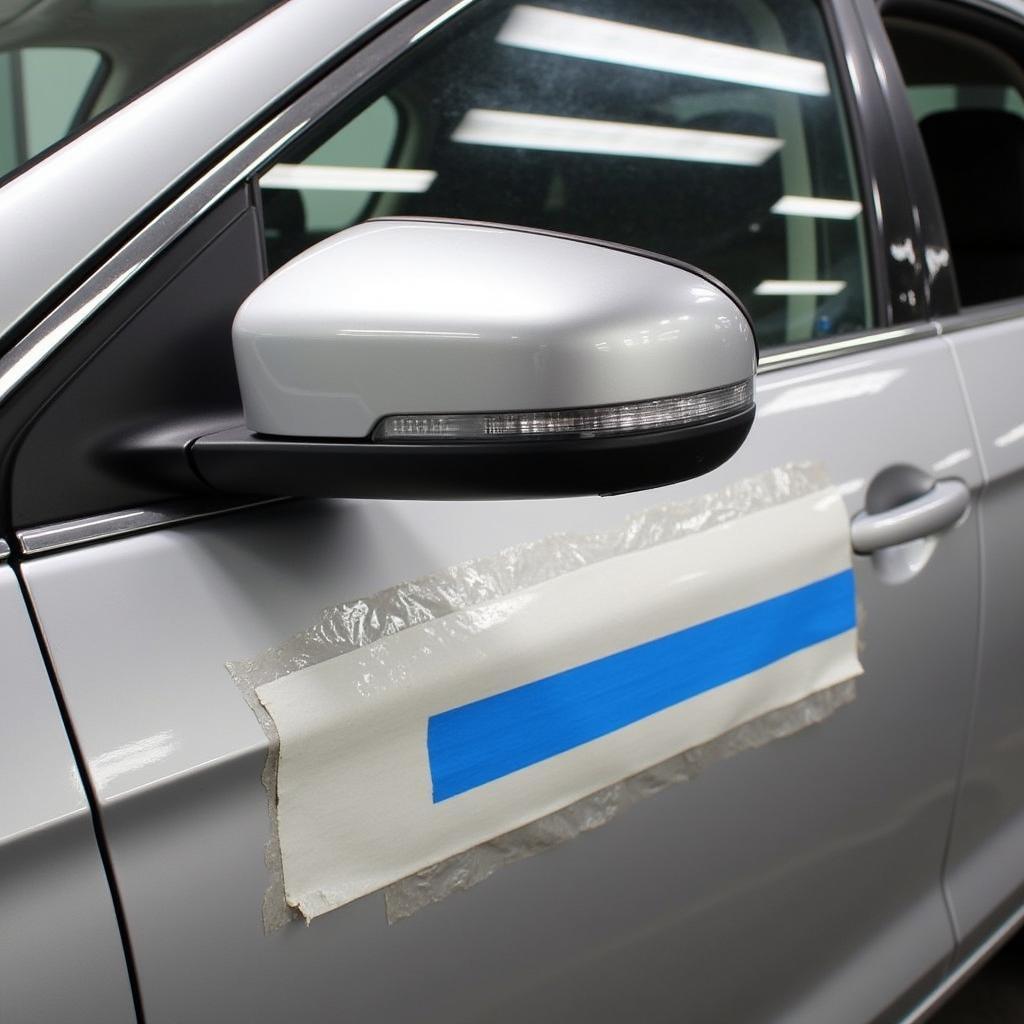Fixing those pesky car paint scratches yourself can be a tempting way to save money and maintain your car’s pristine look. While professional help is always recommended for deep or extensive damage, minor scratches can often be tackled at home with the right approach and a bit of patience. This guide will walk you through the process of assessing the scratch, gathering the necessary materials, and executing a DIY repair that can bring your car’s paint job back to its former glory.
Assessing the Damage: Is DIY Repair Feasible?
Before you roll up your sleeves, it’s crucial to determine the severity of the scratch. Take a close look at the damage and ask yourself the following questions:
- Depth: Does the scratch penetrate the clear coat and reach the base paint layer, or is it a surface-level blemish? Scratches that only affect the clear coat are generally suitable for DIY repair.
- Extent: Is it a single, small scratch, or a larger, more complex web of damage? DIY repairs are best suited for minor, isolated scratches.
- Location: Where is the scratch located on your car? Areas with complex curves or intricate bodywork might be more challenging for DIY fixes.
If the scratch seems shallow, isolated, and located on a relatively flat surface, you’re likely in good shape for a DIY repair. However, if you’re dealing with deep gouges, extensive damage, or scratches in hard-to-reach areas, seeking professional assistance from a reputable car paint repair service like the one offered in mobile car paint repair hamilton is highly recommended.
Gathering Your Car Paint Scratch Repair Arsenal
Once you’ve assessed the damage and decided that a DIY approach is feasible, it’s time to gather the necessary tools and materials. Here’s a checklist to get you started:
- Car Washing Supplies: A clean surface is paramount for a successful repair. You’ll need car wash soap, a wash mitt, microfiber towels, and a bucket.
- Sandpaper: To smooth out the scratch and prepare the surface for paint, you’ll need sandpaper in various grits, typically ranging from 1500 to 3000 grit.
- Rubbing Compound: This abrasive compound helps to further refine the sanded area and remove any remaining imperfections.
- Polishing Compound: This compound follows the rubbing compound to restore the shine and gloss to the paintwork.
- Touch-up Paint: Choose touch-up paint that precisely matches your car’s paint code. This information can usually be found on the vehicle identification plate located inside the driver’s side door jamb.
- Paint Applicator: Depending on the type of touch-up paint you choose, you might need a fine-tipped brush, a pen applicator, or both.
- Masking Tape and Paper: These will help you protect the surrounding areas of your car from accidental paint splatters or sanding marks.
- Microfiber Cloths: You’ll need plenty of clean microfiber cloths for wiping, buffing, and polishing throughout the repair process.
Prepping the Surface for Car Scratch Repair
A clean and properly prepared surface is essential for a seamless and long-lasting repair.
- Wash Thoroughly: Begin by thoroughly washing your car to remove any dirt, grime, or contaminants that could interfere with the repair. Pay extra attention to the area around the scratch.
- Dry Meticulously: Use a clean microfiber towel to dry the car completely. Ensure there are no water droplets or streaks left behind.
- Mask Off the Area: Using masking tape and paper, carefully mask off the area surrounding the scratch. This will protect the surrounding paint from accidental damage during the sanding and painting process.
 Preparing car for scratch repair
Preparing car for scratch repair
Repairing the Car Paint Scratch: A Step-by-Step Guide
Now that your car is prepped and ready, let’s dive into the step-by-step process of repairing the paint scratch.
- Sanding: Start with the lowest grit sandpaper (around 1500 grit) and gently sand the scratch in a back-and-forth motion, following the direction of the scratch. The goal is to feather out the edges of the scratch and create a smooth transition. Gradually increase the grit of the sandpaper (1500, 2000, 2500, 3000), sanding between each grit change to ensure a progressively smoother finish.
- Cleaning: After sanding, thoroughly clean the area with a microfiber cloth and soapy water to remove any sanding residue. Dry the area completely with a clean microfiber towel.
- Rubbing Compound: Apply a small amount of rubbing compound to a clean microfiber cloth and buff the sanded area in a circular motion. The rubbing compound will help to further refine the surface and remove any remaining imperfections. Wipe away the excess compound with a clean microfiber cloth.
- Polishing Compound: Similar to the rubbing compound, apply a small amount of polishing compound to a clean microfiber cloth and buff the area in a circular motion. The polishing compound will restore the shine and gloss to the paintwork. Wipe away the excess compound with a clean microfiber cloth.
- Touch-up Paint Application: Depending on the severity and visibility of the scratch after the previous steps, you may or may not need to apply touch-up paint. If the scratch is still noticeable, carefully apply a thin coat of touch-up paint to the affected area, following the manufacturer’s instructions. Allow the paint to dry completely before proceeding to the next step.
- Final Polishing: Once the touch-up paint is dry (if applicable), use a clean microfiber cloth and a small amount of polishing compound to blend the repaired area with the surrounding paintwork. This will ensure a seamless and professional-looking finish.
Post-Repair Care: Maintaining Your Handiwork
Congratulations! You’ve successfully tackled that car paint scratch. To keep your car looking its best and preserve your handiwork, here are a few post-repair care tips:
- Avoid Washing for 24 Hours: Allow the touch-up paint (if applied) ample time to cure before washing your car.
- Wax Regularly: Regular waxing helps to protect the paint and prevent future scratches.
- Touch Up Minor Scratches Promptly: Addressing minor scratches as soon as possible prevents them from worsening and causing more extensive damage.
Frequently Asked Questions (FAQs)
Q: Can I use nail polish to repair car paint scratches?
A: While it might seem like a quick fix, using nail polish is not recommended for car paint scratch repair. Nail polish is not designed to withstand the harsh conditions of the road and can eventually chip, peel, or discolor, making the scratch more noticeable.
Q: Can I use toothpaste to remove car scratches?
A: Toothpaste is often touted as a DIY solution for minor scratches, but its effectiveness is limited. Toothpaste can help to minimize the appearance of very fine scratches by temporarily filling them in, but it won’t offer a lasting solution.
Q: How much does it cost to professionally repair car paint scratches?
A: The cost of professional car paint scratch repair can vary depending on the severity of the damage, the size of the area, and the location of the repair shop. It’s always a good idea to obtain quotes from reputable shops to compare prices.
Q: Can I repair deep scratches myself?
A: Deep scratches that penetrate beyond the clear coat and into the base paint layer are best left to the professionals. These repairs often require specialized tools, techniques, and expertise to achieve a seamless and long-lasting finish. For deeper scratches, explore options for repair car paint chip or consider consulting with a professional.
Q: What are the common causes of car paint scratches?
A: Car paint scratches can be caused by a variety of factors, including minor accidents, door dings, road debris, shopping carts, and even tree branches.
Need Help With Your Car?
For expert assistance and reliable solutions for all your car repair needs, contact us via WhatsApp at +1(641)206-8880 or email us at [email protected]. Our dedicated team of professionals is available 24/7 to provide you with top-notch support and guidance.

